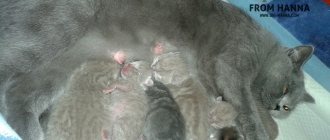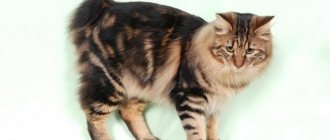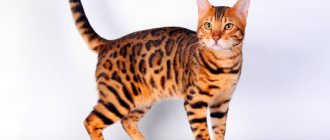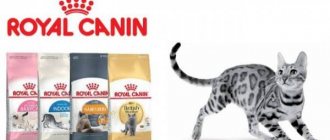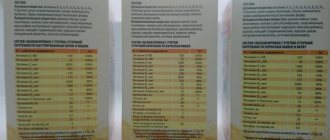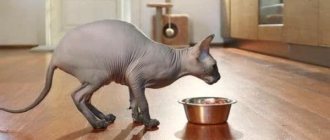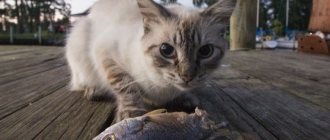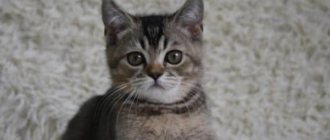The Scottish Fold cat is famous for its friendly character and unpretentiousness in care and feeding. These qualities, along with their good looks, have made the breed one of the most desirable and in demand. Of course, like any cat, the Scotsman, even a kitten, prefers a carnivorous diet based on meat. Everything that is laid down in childhood will affect the health of an adult cat, so we will figure out how to properly feed representatives of this breed at a young age.
Basics of a balanced diet
The quality of food your pet consumes ultimately determines its well-being and appearance. It has been proven that timely introduction of certain products into the diet launches programs for the formation of mental processes and characteristics. For example, if the first food after milk for Scottish Fold kittens was meat, then the kids learn hunting skills earlier and more effectively, and develop more dexterous and nimble.
The choice of feeding type is the responsibility of the owner. And here you cannot rely only on personal preferences and stereotypes. There is a whole science - veterinary dietetics, which develops specialized diets for animals with different nutritional details. Nutritional requirements vary among animals and feeds are also classified accordingly:
- By age: for adult cats, for young cats, for kittens, for aging cats;
- By type of coat: for long-haired cats, for “hairless” cats;
- According to the degree of activity and type of keeping: for active cats, for sedentary cats, for homebody cats;
- According to gastronomic preferences: for picky pets, for those prone to skin problems;
- By life stage: for feeding animals during the breeding period, for pregnant and lactating cats;
- By health factor: for those prone to allergies, food for cats with sensitive digestion, for urolithiasis, for liver problems, etc.
Depending on the type of raw material, feeding can be natural (food from the table and homemade dishes) and professional (ready-made dry and canned food). These two options can be combined to varying degrees, and then we get mixed feeding (when dry food is added directly to natural food) and combined feeding (dry food and natural products are given at different meals). The main balance substances include proteins (proteins), fats (lipids) and carbohydrates (sugars). Their origin and energy value vary depending on the type of raw material. The same applies to the balance of minerals, vitamins and essential acids.
What not to feed
Scottish cats have a sensitive digestive system. This is an artificially bred breed that is not as healthy as barn cats. Therefore, what their outbred brothers eat is completely unsuitable for them.
In order for the kitten to develop properly, it should not be fed:
- Chocolate and other sweets depress the cardiovascular system, increasing the risk of developing diabetes and other metabolic disorders.
- Salty foods – normally, a cat should consume about 21 mg of salt per day. This amount is included in ready-made food and natural products - there is no need to add salt to your pet’s food. Excess sodium chloride leads to leaching of useful substances and disruption of metabolic processes.
- Spicy, spicy, fried, pickled food - such food is inaccessible to animals in the wild, so their body cannot cope with its processing.
- Sausages and smoked meats contain spices and artificial additives that overload the liver.
- Tubular bones - easily split and can injure the esophagus and stomach.
- Fatty foods cause damage to the pancreas.
- Canned food, semi-finished products, fast food - they contain preservatives and other harmful components that destroy the digestive and urinary systems of the Scottish kitten.
- River fish - contains a lot of small bones that a cat can choke on.
- Onions and garlic - destroy red blood cells and, if consumed frequently, cause chronic poisoning.
- Rhubarb and sorrel are toxic to cats. A high concentration of acids leads to urolithiasis.
- Grapes, raisins - provoke vomiting and diarrhea, worsen kidney function.
- Citrus fruits - contain oils that depress the liver, and the pungent odor negatively affects the sense of smell.
- Mushrooms are too heavy food for a cat’s body and are practically not digestible.
- Legumes – cause fermentation in the stomach and bloating.
- Bakery products and pasta lead to constipation and colic.
- Potatoes – cats cannot digest starchy foods.
Alcohol and caffeinated drinks are contraindicated for pets.
Food for Scottish cats must be fresh. It is prohibited to give expired products.
Why is natural feeding not always better?
Food for Scottish Fold cats must be balanced, if only because the breed has some tendency to digestive diseases. And cats living in the house almost always begin to suffer from urolithiasis and obesity with age. Feeding with such metabolic features must be selected with caution and a balanced diet must be followed from early childhood.
Natural feeding would be ideal for the Scots if each owner could independently calculate the optimal balance of the diet for all nutrients and microelements. Selecting foods for such a diet is not an easy task. How, for example, can one calculate how many nutrients a cat received after eating a mouse or catching a pigeon? How different is the nutritional value and calorie content of identical pieces of sea fish and turkey? What vitamins and minerals should be added to the diet of Scottish Fold kittens so that they grow up to be excellent representatives of their breed? Homemade natural feeding is unlikely to be able to take into account all the nuances.
INTERESTING! In extreme conditions, cats can go for long periods without food. They can lose up to 40% of their weight without serious health consequences.
About proteins, fats and carbohydrates
The average cat's diet should contain a lot of fats, which are valuable not only in themselves, but also help in the absorption of vitamins A and E. A lack of fat leads to weight loss, vitamin deficiency and related problems of skin, coat and digestion. And excess is a direct road to accumulation and obesity. However, with age, the proportion of fat should increase slightly.
The share of protein (or rather, proteins of different origins) in the daily diet should be at least 26%. These percentages are calculated by the ratio of the so-called dry residue, since ordinary food contains about 70% water. The higher the “construction” costs, the higher the protein indicator. Food for pregnant and lactating cats and growing kittens should contain the most protein.
Something else interesting: Food for old cats
For example, in a standard factory diet for kittens, protein is at least 35%, and fat from 12 to 24%.
And these are just proteins and fats, but there are also a lot of vitamins, minerals, microelements and special needs. Do you still intend to feed your cat natural food and do it according to all the rules? To know what to feed a Scottish Fold kitten as part of a natural diet, you will have to learn to count not only calories.
Ready-made factory feed
The easiest way to organize the nutrition of your beloved pet has always been feeding it with ready-made factory food. Manufacturers offer a huge selection of diets and veterinary diets for any needs of cats and kittens, taking into account the financial capabilities of the owners.
The quality of the products is almost always high, and the price consists of the cost of individual components. For example, food based on salmon is always more expensive than dry food with a chicken base. Cats can be picky about the taste and variety of food, so food brands offer entire menus. For kittens, there are usually three flavors: poultry, game and fish with different combinations of additional components.
The new owner will have to change food for a growing Scotsie twice: when the kitten is 3-4 months old and when he becomes an adult (9-12 months). The nutritional value of food for kittens and young animals varies, as does the vitamin and mineral balance. In any case, feeding ready-made diets has undeniable advantages:
- The cat always receives fresh food (from a bag, jar or pouch);
- The feed balance strictly corresponds to current needs;
- It is easy to control the amount of food eaten and follow the feeding norm;
- There is no need to waste time searching for ingredients and preparing food.
When the kitten grows up, it will need to be switched to “adult” food. You can feed your Scottish cat ready-made food for the rest of its life. It's convenient and safe. The most preferred food groups for adult Scottish cats:
- Food for cats with digestive problems;
- Food for long-haired cats or marked “from hairballs”;
- Pedigree food for Scottish cats;
- Food for sedentary pets or labeled “weight control”;
- Food for sterilized cats and neutered cats (according to age).
Features of food selection
When choosing food for Scottish fold cats, it is not always possible to save money. Cheap food is often based on by-products and grains, which do not contribute to the proper development of the animal and negatively affect the pet’s sensitive digestive system. Therefore, if you are going to purchase food in a store, then pay attention to premium, superpremium and holistic products.
Remember that you can only combine wet and dry food if they are produced by the same manufacturer. Do not combine different products during the same meal. For example, wet food is given in the evening, and dry food in the morning, or vice versa.
For kittens
You should start thinking about purchasing food for a Scottish Fold kitten only a month after the baby is born. Before this, he gets everything he needs from his mother's milk. From the age of one month, small portions of finely chopped meat and special food are introduced into the kitten’s diet. In this case, it is better to soak dry and hard granules in a small amount of water. This will make it much easier for the kitten to eat them.
Table: food for Scottish Fold kittens
| Name of food | Type | Advantages | Composition basis | Manufacturer country |
| Wahre Liebe Junge | Dry | Prevention of urolithiasis and the formation of hairballs in the digestive tract |
| Germany |
| Hill's Science Plan Kitten Tuna | Dry | Strengthens immunity |
| USA |
| 1st Choice Kitten | Dry | Does not cause allergic reactions | Chicken | Canada |
| Royal Canin Kitten Instinctive | Wet | Strengthens immunity |
| USA, France |
| Royal Canin British Shorthair Kitten | Dry and wet | Prevention of joint diseases | Poultry meat | France |
Photo gallery: food for Scottish Fold kittens
Complete super premium food Wahre Liebe Junge is designed for kittens from 2 months to 1 year Hill's Science Plan Kitten Tuna food is excellent for maintaining immunity and healthy digestion 1st Choice Kitten - an ideal formula for initial complementary feeding of a kitten from 2 months, when he needs new sources nutrition instead of mother's milk Royal Canin Kitten Instinctive helps support the kitten's natural defense mechanisms in the second phase of growth Royal Canin British Shorthair Kitten food is created specifically for British shorthair kittens, taking into account all the physiological needs of their body
Video: first feeding of kittens
Natural products in a kitten's diet
The menu of a kitten up to one year old, as well as the diet of an adult Scotsman, must include meat. Poultry, beef or rabbit are suitable for these purposes, which will form the basis of the menu. Additionally, the baby’s diet includes:
- heart;
- lungs;
- kidneys;
- other by-products.
Finely ground chicken necks and heads will help replenish the kitten's calcium deficiency in the body. Fish is given no more than once a week to kittens older than five months. Also used as nutritional supplements:
- non-sour cottage cheese;
- cheese;
- dairy products;
- egg yolk;
- vegetables;
- greenery;
- unrefined vegetable oils.
For adult animals
Adult cats can handle any food, regardless of its consistency. Therefore, they often buy dry food, which is cheaper. In addition, jellies, sauces and natural food spoil faster, so it is not recommended to leave them in your pet’s bowl for more than two hours.
Table: food for adult Scottish Fold cats
| Name of food | Class | Type | Features of the composition | Approximate cost of production | Manufacturer country |
| Acana Pacifica for Cats | Holistic | Dry | Grain-free food high in protein (35%) and fat (19%) |
| Canada |
| Earthborn Holistic, Primitive Feline Natural Cat Food | Holistic | Dry and wet |
|
| USA |
| 1st Choice Adult Cat Chicken Formula | Superpremium | Dry and wet |
|
| Canada |
| Royal Canin British Shorthair | Premium | Dry and wet |
|
| France |
| Flatazor Crocktail Adulte Poissons | Premium | Dry and wet |
|
| France |
Photo gallery: food for adult Scottish Fold cats
Acana Pacifica for Cats food is completely grain-free. Earthborn Holistic food contains fresh sea fish, rich in vitamins and Omega-3-6-9 acids 1st Choice Adult Cat - dry complete food with chicken for adult cats living in domestic households conditions The food used for British shorthair cats is also suitable for Scottish fold cats, Royal Canin British Shorthair is one of them. The taste and balanced composition of Flatazor Crocktail Adulte Poissons with fish allows you to choose it as a daily diet for an adult cat in order to ensure a high-quality and rich life
Natural products in the diet of the Scottish Fold cat
If you decide to feed your cat natural products, then first of all find out the weight of your pet, since the menu options presented below are made based on 1 kg of body weight. The first recipe looks like this:
- lean fresh beef (pour boiling water) – 25 g;
- light - 5 g;
- pure water - 10 g;
- vegetable oil - 2 g;
- dry regular yeast - 0.2 g;
- plain oat flakes - 4 g.
To create variety in your cat's diet, the ingredients described above can be replaced with others. At the same time, the energy value of the food will not decrease, and your pet will receive all the necessary nutrients. For this you will need:
- fresh liver - 10 g;
- lean fish - 25 g;
- buckwheat - 4 g;
- plain water - 7 g;
- regular dry yeast - 0.1 g;
- low-fat cottage cheese - 3 g.
Having chosen the appropriate recipe, grind the required amount of ingredients and mix thoroughly. The finished mixture, which resembles minced meat in consistency, can be divided into portions and frozen. This way you can save time and do without regularly preparing food for your cat.
About feeding Scottish kittens
It is recommended to do the first feeding in this breed a little later than in “wild” type breeds (Abyssinian, Siamese cats). Scots are often formed with a slight delay. This is not a pathology, but only a feature of genetics. While average kittens are ready for their first food at the end of the third week of life, Scottish Fold kittens will try their first meat (or soaked food) a week later.
INTERESTING! Beginning breeders should know that if the first complementary food is meat (for example, a scrape from a heavily frozen piece of selected beef), then the mental development of kittens will be more intense.
Ready-made food or natural food
You need to choose a feeding regimen based on individual characteristics. When it comes to finances, a natural diet with good meat costs about the same as a premium food choice. The main advantage of industrially produced food is that it is ready to eat and properly balanced. No need to waste time preparing.
Mixed feeding option
Veterinarians are prohibited from mixing two different diets. This leads to an imbalance in the digestive system. Such nutrition threatens disorders, deterioration of the animal’s health and other negative consequences. The food for Scottish Fold kittens should be either natural or ready-made food.
About gluten intolerance in Scots
Gluten is the gluten found in cereals. Allergies to this substance in cats are very rare. Often people themselves switch their pets to gluten-free food due to fashion and trends popular in society.
Checking your kitten for allergies
If you suspect an allergy, you will have to take an immunoglobulin test. Such reactions may include redness, irritation, itching and other symptoms. New foods should be introduced into a kitten’s diet gradually. To begin with, there should be small pieces of new food. After some time, it is worth assessing the condition of your pet.
Food for Scottish cats can be, like for any other cats, natural and ready-made. Ready-made food, especially if it belongs to the premium segment, already has a balanced composition. Cat owners will have to create a natural diet on their own, taking into account the needs of the animal.
Natural kitten diet
Kittens of the second month of life should still receive mother's milk along with complementary foods for some time. This is important for promoting good behavior and health. If the breeder weans the kittens from the nipple earlier, then later (after about six months) the first problems with friendliness and quality of digestion may arise, and it happens that such forms of behavior as sexual and territorial behavior are impaired due to milk underfeeding. It turns out how important it is to feed dairy kittens to their fullest.
After 3 months, when kittens are completely ready to feed on their own, the amount of cow's milk and its derivatives should be reduced. Cats often enjoy lapping up milk all their lives, but this is not always good for digestion, because... enzymes that break down milk protein cease to be synthesized.
In general, a kitten’s natural diet should include:
- Several types of meat;
- Ocean or sea fish;
- Eggs, cottage cheese, low-fat sour cream, kefir, a small amount of milk;
- A small amount of vegetables and fruits as a source of vitamins and coarse fiber (but how to get a cat to eat fruit?);
- Plant and animal fats, taurine, carnitine;
- A small amount of cereals as a source of plant fiber;
- Ready-made vitamin and mineral complex according to your needs.
It is not easy to balance all these components in the diet of a small, growing kitten whose nutritional needs are constantly changing. It is much easier to pay attention to the finished product. However, if the owner still wants to feed his cat food from the table, then as an alternative, veterinarians recommend using ready-made diets temporarily - at least up to 8-9 months. By this point, the period of intensive growth will end, and the kitten can be fed with the food that seems more acceptable to the owner. But still, it is better to choose ready-made food.
Something else interesting: How to properly feed a two-month-old kitten
How to feed a neutered Scottish cat
Castrated animals often suffer from the fact that they move less, and since they also lose interest in sexual hunting, the only joy in life remains food. They also disrupt the production of hormones that affect the feeling of satiety. Such animals cannot be overfed, otherwise they will become obese. But depriving them of joy is also not good, so you need to find a middle ground: you can feed a castrated cat and a sterilized cat 2-3 times a day, but in smaller portions.
The animal can also be switched to a lower-calorie diet. If this is a natural food, add more vegetables to the meat so that the amount of fiber filling the stomach is greater. If this is factory food, then there are special lines for castrates. However, they often overdo it with vegetable and grain components, as a result of which cats simply do not get enough to eat.
Kitten feeding regimen
For healthy growth and development of kittens, not only the composition and type of food is important, but also the feeding regimen. Depending on age, you will have to change the number of feedings and their composition. Pay attention to the daily food intake at each age:
| Kitten age | Type of feed | Number of feedings | Daily norm |
| up to 1 month | Scraped meat Mother's milk Formula/porridge | 15-71 | PeaUntil saturation 20 g |
| 1-2 months | Mother's milk Complementary feeding | 1-24-5 | Until saturation Dry food: 20 g/kg weight Wet: 120-150 g. |
| 3-6 months | Any | 4 | Dry food: 20 g/kg weight Wet: 180-250 g. |
| 6-9 months | Any | 3 | Dry food: 20 g/kg weight Wet: 200-300 g. |
| 10-12 months | Any | 2 | Dry food: 20 g/kg weight Wet: 150-250 g. |
As we can see from the table, the maximum nutritional requirement is observed in kittens at 6-9 months. This is a period of intensive growth, puberty, formation of the psyche, behavior and social contacts. At this time, the kitten needs a large number of different nutritional components. Feed brands take these needs into account and offer ready-made balanced diets.
IMPORTANT: do not combine food from different manufacturers or different lines of the same manufacturer in your diet. Their balances may differ significantly. It is best to choose dry. And wet food of the same brand and line.
Do not forget that the kitten should not be allowed to actively move immediately after eating. It is advisable to take a 15-20 minute break before games. With any type of feeding, the kitten should always have access to clean drinking water, which cannot be replaced with other liquids.
Feeding secrets for a good character
How to feed a kitten in early childhood determines how healthy and beautiful it will grow up. It is better for the breeder to feed the first complementary foods by hand rather than from a bowl. This will form additional contact between the cat and the person and help establish a positive, friendly character.
Cats respect rituals and rules, so before you feed your Scottish cat, invite her to come with the command “Come here” and sit opposite you. Then put the bowl down and let him eat. In the future, this will save the cat from eating food that is not its own and stealing from the table - it will wait for the command to eat. You can start such exercises with 1.5-2 month old Scottish kittens.
You should not exceed the daily feeding allowance or supplement your cat with food from your own table. Despite the unpretentiousness of the Scots, their health is not always ideal. The breed has a tendency to be overweight and have heart and genitourinary diseases. Therefore, the nutrition of a Scottish cat at any age must be carefully balanced and meet the needs of the body. And when feeding a kitten, you need to pay special attention and strictly follow the regimen.
Menu and diet for Scottish cats
Food is served in the form of pieces - small or large, if the animal can tear them. Minced meat, jellied meat and liquid food are not suitable for healthy Scottish cats.
Below is a menu of natural food, which is preferable. Let's list the foods that an adult cat's diet should consist of. So, what can you feed fold-eared and straight-eared cats?
Meat (obligatory and main product)
Low-fat varieties of meat are suitable for Scottish and British cats, because... The pancreas cannot cope with excess fat, resulting in pancreatitis. Lean meats include chicken, rabbit, quail, horse meat, turkey, and some parts of beef. The ideal meat for cats is poultry and rabbit. Pork should not be given raw.
Breeders also recommend chicken. At the same time, the MURKOTIKI website, after consulting with nutritionists, does not recommend chicken that you are not sure about. According to doctors advising the site, chicken, especially broilers, contains many hormones that are fed to poultry in factories and even in households. Plus other harmful substances. Therefore, it is better to prefer turkey meat to chicken as a more environmentally friendly product. If you have access to environmentally friendly chicken, then you can and should use it.
Meat is given raw (preferred option) or boiled, but in no case fried or smoked. Whether to feed a Scottish or British cat raw meat is up to each owner to decide for himself. On the one hand, cooking kills many beneficial substances. On the other hand, raw meat sometimes contains worms, which do not always die during the obligatory three-day freezing in the refrigerator before serving to the cat. Feeding without freezing, that is, fresh meat, is prohibited.
It is worth noting that meat grown on an industrial scale most often does not contain worms. According to experts, animals in factories are prevented and fed special food, so the risk of infection is minimized. But if you give your cat hunting or farm meat, there is a possibility of infection. Not every farmer regularly prevents their animals, and they sometimes eat food that may be contaminated. Of course, this does not apply to all farms.
It is advisable to place the meat in a bowl in the form of pieces and large pieces so that the animal strengthens its chewing apparatus.
Bones are also regularly added to the diet. They are useful because cats use them to brush their teeth, and also because in the process of eating meat from a bone, or just a large piece of meat, the tailed cats develop their jaw muscles. In addition, bones contain useful substances. For this reason, an adult cat does not need to be constantly given minced meat or small pieces of meat, because... this will cause the muscles to weaken. In addition, adult cats love meat in tangible pieces more. “MURKOTIKI” has prepared a separate article on how to feed cats meat with bones, because... This is an important issue: failure to follow the rules can lead to the death of the animal!
Article continues after advertisement
Cats on a natural diet usually go to the toilet once a day or once every 2 or even 3 days - these are normal options. But you need to monitor the stool: if the cat is prone to constipation, up to 5-10% vegetables and (or) bran are added to the meat (some add porridge, but this is wrong). A cat's complete digestive cycle takes 24 hours.
Mixes are recommended as daily food for cats: pieces of meat, offal, oatmeal, raw vegetables (carrots, broccoli, pumpkin, zucchini, etc.), herbs, raw quail eggs. This mixture is prepared in advance, then frozen in the freezer in separate portioned bags, after which it is defrosted as needed, brought to room temperature and served to the pet. The meat in this mixture is raw.
Mixes are an alternative to monofeeding, when different types of meat are not mixed in one meal. Instead, they are served at different meals. This should not be confused with constantly feeding one type of meat: this is not considered a balanced diet. According to veterinarians, both mixes and monofeeding have a right to exist. The advantages of monofeeding are a happy pet, rapaciously devouring whole pieces of meat, as well as the confidence that the gastrointestinal tract will not be confused by incorrectly selected ingredients (for example, a cat may be allergic to one of the ingredients in the mix). The advantages of mixes are that the cat receives all the necessary nutrients in every meal and there is no need to draw up and keep in mind a feeding schedule.
We recommend storing excess meat in the freezer. It is advisable to pre-cut them into portioned pieces so that you can take them out one at a time.
Bran (controversial product)
Porridges are not a recommended food for carnivores, because... They are practically not absorbed and even interfere with the absorption of nutrients from other foods. With frequent consumption of grains (porridge), cats are at risk of diabetes, urolithiasis, and thyroid problems. It is better to prefer bran to porridge.
A cat can also get grains from special grass that is sprouted in a pot. The collections usually consist of wheat, barley, millet, etc. The grass is rich in vitamins and also helps the cat move the fur that has gotten into it through the gastrointestinal tract. If it is difficult to move it forward, then the cat vomits after the grass - and the fur comes out through the mouth. Therefore, every cat must have free access to grass. Just don’t bring it from the street: wild grass can contain parasites and infections.
Fish (optional)
Cats and fish are an established stereotype that has become the basis of more than one commercial. But, in fact, fish should not be a frequent guest on the cat’s table: once a week - no more. If there is an excess of fish food, kidney problems may develop, and the cat will also begin to prefer only fish products, neglecting healthier food.
Cats can only eat boiled sea fish; river and raw fish are prohibited. Firstly, such fish almost always contain parasites. Secondly, it contains a number of substances that negatively affect the digestibility of beneficial elements. Even those owners who allow the consumption of raw meat do not feed cats raw fish. Although there are some fans of a raw food diet who serve all products in an unprocessed form.
It is important to choose the right type of fish. It should not be overly oily. And it is worth considering that many types of fish (carp, pike, bream, whitefish, smelt, minnow, chub, catfish, gukuchan, ide, herring, herring, capelin, sardinella, smelt, crucian carp, perch, tench, burbot, chebak, sprat , sprat, anchovy, sorog, bream, Argentina) contain the enzyme thiaminase, which destroys vitamin B1. You can eat such fish, but not often. But you should not feed fish from the cod family, because it develops iron deficiency anemia and hair depigmentation. Salmon fish (salmon, pink salmon, trout), as well as hake, catfish, mackerel, sawfish, tuna, etc. are good for cats.
Seafood (as a treat)
Many cats happily eat squid, shrimp, mussels and rapana. Such food is not so easy for the cat’s body to digest, so it should not be the rule, but an exception in the form of a treat: once or twice a month is enough.
Article continues after advertisement
Dairy products (recommended product)
Low-fat fermented milk products (kefir, fermented baked milk, yogurt, unleavened cheese, whey, cottage cheese) are good for the health of cats: they contain a lot of protein, calcium and vitamins, and also help good digestion. It is undesirable to consume fatty dairy products, such as sour cream, in large quantities, because... this can negatively affect pancreatic health.
Let's talk separately about milk. It is not advisable to give it to adult cats. From about 3 months they develop lactose intolerance. If you want to please your pet, because... he loves this product, buy special milk or cream for cats. Read more about milk in the diet of Scottish cats.
Eggs (a must)
Chicken yolk, as well as quail yolk and white, should be a mandatory element of the Scottish cat’s diet approximately once a week. Chicken yolk should be given raw (if you are sure of its purity) or boiled; the protein is thrown away, because It's not good for cats. But a quail egg can be given whole and raw.
Raw eggs are an excellent source of vitamins (in particular, vitamins A, D, E and group B), as well as calcium, phosphorus, iodine, iron and other trace elements.
Vegetables (optional, but recommended)
Vegetables are also good for your pet: they contain fiber, which helps avoid constipation, and vitamins. B vitamins are especially important in vegetables; cats are very easily deficient in them, since they do not accumulate excess vitamins but excrete them daily. That is, B vitamins should be supplied in sufficient quantities every day. Veterinary expert Maria Dorosh recommends including vegetables in your cat’s diet, although this is not necessary.
Vegetables can be served raw or cooked. It is necessary to take into account that vitamins are destroyed during cooking, therefore, from the point of view of saturating the body with vitamins, it is better not to cook vegetables. But the starch of boiled vegetables is better absorbed, so cooking is recommended for cats who have problems digesting food: for them, boiled vegetables are a gentler option. Once your digestion returns to normal, you can switch to raw and lightly cooked vegetables. To make them easier to digest, they are added in small pinches and first grated.
Particularly useful are carrots (it is better to boil), beets (you need to boil, but this product can cause diarrhea and vomiting), cucumbers (give raw), zucchini (can be boiled and given raw), pumpkin, broccoli (lightly cooked), white cabbage (its , on the one hand, is not recommended because it causes flatulence, on the other hand, it is an excellent prebiotic, so you can periodically add a pinch of shredded cabbage).
Most often, cats refuse to eat vegetables separately, so you can mix them with meat and pour over meat broth to add flavor.
Greens (recommended product)
Cats benefit from parsley, dill, lettuce and other green foods. Sometimes cats eat them without anything. Sometimes they play with them and eat them as prey. Sometimes they are preferred instead of grass on the windowsill. Experiment.
Nutritional Supplements (Recommended Product)
You can add bran and meal (buckwheat, flaxseed, etc.) to the main diet. A pinch with food helps intestinal motility.
Dried kelp cleanses the body of toxins, helps to go to the toilet and enriches it with iodine. It is enough to periodically add a pinch to food.
Vegetable oils (hemp, sesame, sea buckthorn, olive, pumpkin, but not sunflower) deliver vitamins to the body and help digestion. But we repeat, they are practically not digestible, so it is better to prefer animal fats. However, many owners note positive changes in the coat when adding vegetable oils to the diet.
An important food supplement is fish oil (it contains fatty acids that are important for the cat’s body, including Omega-3 and Omega-6). You can purchase it as a supplement. Just keep in mind that fish oil quickly loses its beneficial properties after contact with air, so it is better to buy it in capsule form and open one at a time before adding it to food. However, cats that regularly consume fatty fish do not need a separate fish oil supplement.
Attention, life hack! It happens that you have run out of frozen meat, but you haven’t had time to prepare new meat. Then you can buy deep-frozen meat at the supermarket, defrost it and serve it to your cat.
Prohibited foods: what not to feed Scottish cats
And now about what is absolutely forbidden.
| PRODUCT | PECULIARITIES |
| Sweet | It is not allowed in any quantity. If your cat asks for sweets, it means that he is interested in something else in the product, because cats do not have receptors that recognize sweet taste. Don't buy into your cat's requests, because he can quickly develop diabetes. |
| Salty | We don’t add salt to cats’ food at all: the minimum amount of salt is contained in meat. We do not serve salty products from the store. |
| Spicy | Kittens are not allowed any spices at all. They upset digestion. |
| Onion garlic | Garlic and onions can cause serious digestive problems. |
| Chocolate | Even if your chocolate is not sweet, as it should be according to the classics, it is still under no circumstances allowed for a cat: for an animal it is poison. |
| Coffee | Just like chocolate, coffee is poison. If your cat asks you for coffee, he may be attracted to the milk you add to the drink. |
| Milk | Cats are supposed to eat fermented milk, but whole milk, which contains lactose, causes gas and stomach upset. Owners often don’t notice this, but in fact the animals don’t feel well after drinking milk. If you really want to feed your cat milk, pay attention to goat milk or a special milk replacer for cats. |
| Marinades | Cats are not allowed pickled food. This applies to any conservation. |
| Smoked | Just remember that it is poison. |
| Bold | Fatty and fried foods, no matter whether it is meat or not, are not allowed. The pancreas cannot withstand such nutrition. |
| Pork | Cats should not eat fatty parts of pork: repeated consumption of such meat can cause pancreatitis. Lean parts of pork are ok. But it’s better to bake them, because... Pigs suffer from Aujeszky's disease, which is transmitted through raw meat and is fatal to cats. |
| Canned food | Any canned product is always generously supplied with salt, spices and preservatives. This in itself is harmful even for humans, not to mention the cat’s digestive and urinary system, which is much worse adapted to such food than ours. |
| Citrus | As a rule, cats themselves cannot stand lemons, oranges, tangerines and other citrus fruits. But there are also exceptions. The fact is that citrus fruits contain harsh essential oils, which greatly affect the cats’ keen sense of smell. Plus, eating them can cause indigestion. |
| Fruits | The digestive system of cats is not adapted to eating fruits and berries, so they can cause stomach upset. But there are cats who love fruit. If nothing bad happens to them after this, you can periodically allow them to eat this. |
| Mushrooms | Mushrooms are too heavy and not healthy food for cats. |
| Potato | Potatoes are pure starch, which is difficult to digest and is not absorbed by cats. |
| Beans | Peas, lentils, soybeans and other legumes are prohibited because... These are too heavy foods, plus they cause fermentation. |
| Flour | All flour products, including bread, are harmful to cats and have no nutritional value. Instead, it is better to purchase special yeast for cats in the form of a supplement. |
Do not under any circumstances repeat what is shown in the video. The owner fed the cat sweet ice cream for the sake of a funny video.
About gluten intolerance in cats
Some people and cats suffer from gluten intolerance - gluten from wheat, rye, oats (sprouted oat grass does not count) and barley. For some, gluten can cause diarrhea, for others - constipation, for others - inflammation of the intestinal walls and other unpleasant symptoms. It is not easy to make a diagnosis, because... diagnostic methods are ineffective. It’s difficult for people to give up gluten, because everyone loves baking, but for cats it’s very easy.
The MURKOTIKI website recommends that cat breeders make allowances for the possibility of gluten intolerance in their pets and do not initially accustom them to products containing it. We are especially talking about wheat, because... it contains more gluten. That is, no bread or pasta in the diet. In addition, it is harmful even to cats that do not have gluten intolerance.
If you are using ready-made factory feeds, please note: manufacturers have already come up with gluten-free lines. Such foods are marked “no grain”, “gluten free”, “grain-free”, “does not contain gluten” and the like. Such a line of feed is available, for example, from Farmina ND, 1st Choice, Acana, Orijen, Trainer. This is a super premium and holistic food.
In the case of natural nutrition, everything is much simpler: do not add porridge from wheat, rye, oats and barley, as well as bread, to the meat. Actually, this is not recommended in any case.
